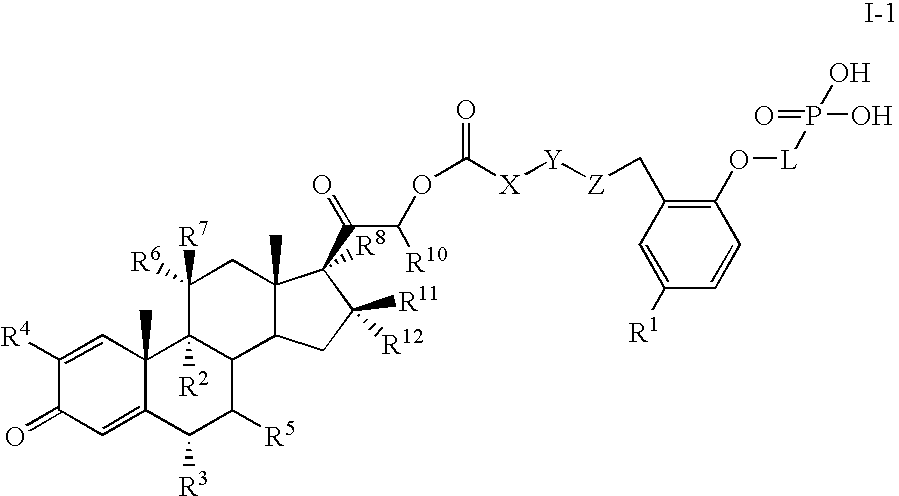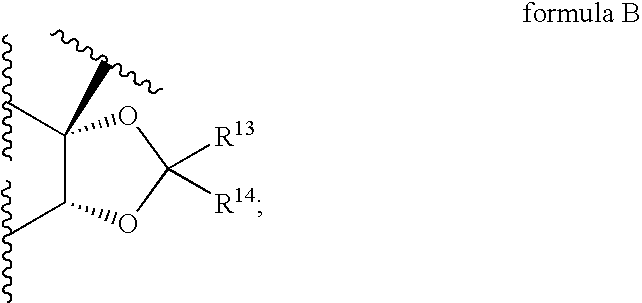Corticosteroid linked beta-agonist compounds for use in therapy
a technology of corticosteroid and beta-agonist, which is applied in the direction of biocide, organic chemistry, drug composition, etc., can solve the problems of limiting the use of long-term therapeutic agents, causing undesirable side effects in the mouth, and profound undesirable side effects of oral glucocorticoid therapies, so as to minimize systemic absorption and high affinity
- Summary
- Abstract
- Description
- Claims
- Application Information
AI Technical Summary
Benefits of technology
Problems solved by technology
Method used
Image
Examples
example 1
[2-[4-(Di-tert-butoxyphosphoryloxy)-3-formylphenyl]-2-hydroxyethyl][6-(4-phenylbutoxy)hexyl]carbamic acid tert-butyl ester
[0496]
[0497]Benzyltriethylammonium chloride (334 mg, 1.46 mmol), dichloromethane (25 mL), and bromotrichloromethane (1.50 mL, 15.3 mmol), were added to a solution of sodium hydroxide (4.7 g, 120 mmol) in water (25 mL). To this biphasic mixtures vigorously stirred at 0° C., was added a solution of di-tert-butyl phosphite (2.92 mL, 14.7 mmol) in dichloromethane (25 mL) dropwise over 5 min. The reaction mixture was then allowed to warm up to room temperature while stirred vigorously for 2 h, at which point, a solution of 2-(3-formyl-4-hydroxyphenyl)-2-hydroxyethyl][6-(4-phenylbutoxy)hexyl]carbamic acid tert-butyl ester (6.03 g, 11.7 mmol) in dichloromethane (25 mL) and N,N-dimethylaminopyridine (143 mg, 1.7 mmol) was added. The mixture was then stirred for another 1 h, after which ethyl acetate (600 mL) was added and the aqueous layer was removed. The organic layer ...
example 2
[2-[4-(Di-tert-butoxyphosphoryloxy)-3-hydroxymethylphenyl]-2-hydroxyethyl][6-(4-phenylbutoxy)hexyl]carbamic acid tert-butyl ester
[0499]
[0500][2-[4-(Di-tert-butoxyphosphoryloxy)-3-formylphenyl]-2-hydroxyethyl][6-(4-phenylbutoxy)hexyl]carbamic acid tert-butyl ester was dissolved in THF (20 mL) and cooled to 0° C. followed by addition of NaBH4 (354 mg, 9.36 mmol) in H2O (4 mL). The resulting reaction mixture was stirred for 30 min then was added H2O (50 mL). The aqueous was extracted with EtOAc (3×50 mL). The combined organic layers were washed with satd. NaHCO3 (100 mL), brine (100 mL), dried over Na2SO4, and concentrated to give crude (4.69 g) alcohol title compound as a light yellow oil. 1H NMR (CDCl3): d 7.17-7.41 (m, 5H), 4.92 (m, 1H), 4.62 (bs, 2H), 3.39 (q, 2H), 2.64 (t 2H), 1.62 (m, 4H), 1.54 (s, 9H), 1.52 (s, 9H), 1.49 (s, 9H), 1.115-1.49 (m, 8H). 31PNMR (CDCl3): −13.060 ppm. LCMS: 99%, MNa+ 730.0 (exact mass 707.4 calcd for C38H62NO9P). Anal. Calc: C, 64.48; H, 8.83; N, 1.98....
example 3
Methanesulfonic acid 5-[2-{tert-butoxycarbonyl-[6-(4-phenylbutoxy)hexyl]amino]-1-hydroxyethyl)-2-(di-tert-butoxy-phosphoryloxy)benzyl ester
[0501]
[0502]To a solution of [2-[4-(di-tert-butoxyphosphoryloxy)-3-hydroxymethylphenyl]-2-hydroxyethyl][6-(4-phenylbutoxy)hexyl]carbamic acid tert-butyl ester (described in Example 2) (1.20 g, 1.70 mmol) and 1,2,2,6,6-pentamethyl-piperidine (615 μL, 3.40 mmol) in dichloromethane (17 mL) at −78° C. was added a solution of methanesulfonic acid chloride (140 mL, 1.78 mmol) in dichloromethane (6 mL) over 5 min. Reaction stirred for 10 min at −78° C. Reaction solution was concentrated and purified by silica gel chromatography (gradient: 30% to 80% ethyl acetate in hexanes, both buffered with 1% triethylamine) to give the title compound as a clear oil (0.805 g, 1.02 mmol, 60%). ES / MS cacld. For C39H64NNaO11PS 808.4, found m / z 808.3 (M+Na+)
PUM
 Login to View More
Login to View More Abstract
Description
Claims
Application Information
 Login to View More
Login to View More - R&D
- Intellectual Property
- Life Sciences
- Materials
- Tech Scout
- Unparalleled Data Quality
- Higher Quality Content
- 60% Fewer Hallucinations
Browse by: Latest US Patents, China's latest patents, Technical Efficacy Thesaurus, Application Domain, Technology Topic, Popular Technical Reports.
© 2025 PatSnap. All rights reserved.Legal|Privacy policy|Modern Slavery Act Transparency Statement|Sitemap|About US| Contact US: help@patsnap.com



